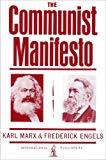
The Communist Manifesto is a document which explains the underlying theory and goals of the Communist Movement. An extremely influential political work, this document critiques capitalism, explaining that the struggles between upper and lower economic classes are what cause historical developments like Revolution. Thus, the Manifesto concludes that capitalism is inherently unsustainable, and that a Communist revolution which results in the elimination of class is required to change the status quo.
A spectre is haunting Europe—the spectre of communism.
— Opening sentence of the Manifesto
The Communist Manifesto is divided into a preamble and four sections, the last of these a short conclusion. The introduction begins by proclaiming "A spectre is haunting Europe—the spectre of communism. All the powers of old Europe have entered into a holy alliance to exorcise this spectre". Pointing out that parties everywhere—including those in government and those in the opposition—have flung the "branding reproach of communism" at each other, the authors infer from this that the powers-that-be acknowledge communism to be a power in itself. Subsequently, the introduction exhorts Communists to openly publish their views and aims, to "meet this nursery tale of the spectre of communism with a manifesto of the party itself".
The first section of the Manifesto , "Bourgeois and Proletarians", elucidates the materialist conception of history, that "the history of all hitherto existing society is the history of class struggles". Societies have always taken the form of an oppressed majority living under the thumb of an oppressive minority. In capitalism, the industrial working class, or proletariat , engage in class struggle against the owners of the means of production, the bourgeoisie . As before, this struggle will end in a revolution that restructures society, or the "common ruin of the contending classes". The bourgeoisie, through the "constant revolutionising of production [and] uninterrupted disturbance of all social conditions" have emerged as the supreme class in society, displacing all the old powers of feudalism. The bourgeoisie constantly exploits the proletariat for its labour power, creating profit for themselves and accumulating capital. However, in doing so, the bourgeoisie serves as "its own grave-diggers"; the proletariat inevitably will become conscious of their own potential and rise to power through revolution, overthrowing the bourgeoisie.
"Proletarians and Communists", the second section, starts by stating the relationship of conscious communists to the rest of the working class. The communists' party will not oppose other working-class parties, but unlike them, it will express the general will and defend the common interests of the world's proletariat as a whole, independent of all nationalities. The section goes on to defend communism from various objections, including claims that it advocates "free love" or disincentivises people from working. The section ends by outlining a set of short-term demands—among them a progressive income tax; abolition of inheritances and private property; free public education; nationalisation of the means of transport and communication; centralisation of credit via a national bank; expansion of publicly owned etc.—the implementation of which would result in theprecursor to a stateless and classless society.
The third section, "Socialist and Communist Literature", distinguishes communism from other socialist doctrines prevalent at the time—these being broadly categorised as Reactionary Socialism; Conservative or Bourgeois Socialism; and Critical-Utopian Socialism and Communism. While the degree of reproach toward rival perspectives varies, all are dismissed for advocating reformism and failing to recognise the pre-eminent revolutionary role of the working class. "Position of the Communists in Relation to the Various Opposition Parties", the concluding section of the Manifesto , briefly discusses the communist position on struggles in specific countries in the mid-nineteenth century such as France, Switzerland, Poland, and Germany, this last being "on the eve of a bourgeois revolution", and predicts that a world revolution will soon follow. It ends by declaring an alliance with the social democrats, boldly supporting other communist revolutions, and calling for united international proletarian action.
Working Men of All Countries, Unite!
— Closing line
Already have an account? Log In Now